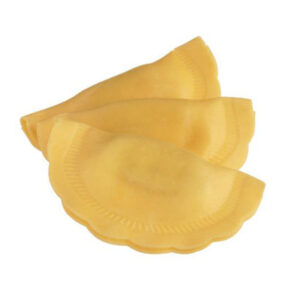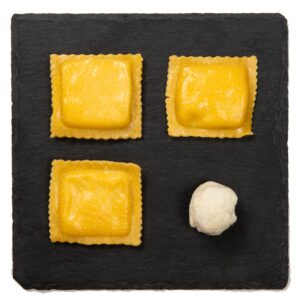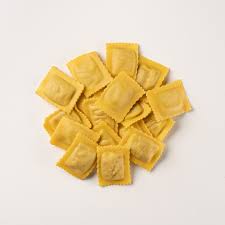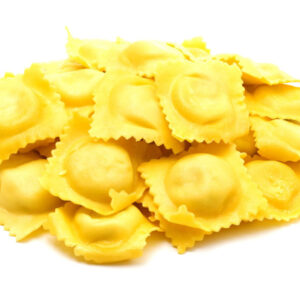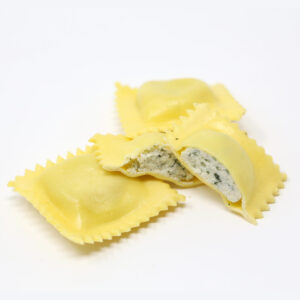Showing all 5 results
Fresh italian pasta shop online
Fresh Italian pasta shop online with 100×100 Italy, your reference point for quality typical Italian products.
We deliver quickly and safely to most of Europe thanks to a widespread and tested network.
Among the top products is fresh pasta, one of the cornerstones of Italian cuisine.
Fresh Italian pasta online shop, products
Fresh pasta is defined as a mixture of wheat flour or durum wheat semolina with water or another more or less liquid substance, in particular eggs. The definition of ‘fresh’ comes from the fact that it contains up to 30% moisture.
On our website, you can find different types of fresh pasta, such as ravioli with porcini mushrooms, ravioli with codfish, ravioli delights with lemon, ravioli with ricotta and parmesan, and ravioli with ricotta and spinach.
Italian fresh pasta online shop, characteristics
The extraordinary thing about fresh egg pasta is precisely this, the ingredients always seem to be just two, flour and eggs, but the combinations of dough are infinite and infinite are the shapes that spring from this dough.
In keeping with tradition, we are talking about homemade pasta, which is not, however, only and exclusively egg pasta; from the flour, which is the mother of everything in the supreme philosophy of pasta, we start to arrive at any other liquid or binder that can enhance the qualities of the flour.
And the same flour can have many different characters, children of the cereal or grain of origin, so it happens that in the regional tradition we often find recipes for homemade pasta without eggs born out of necessity, curiosity or creative challenge.
Here then is an abundance of pastas made only with water and flour, gnocchi of every type and shape, thin pancakes called crespelle or other with which to wrap a thousand fillings, long pastas and short pastas, filled pastas, pasticci, lasagnas and a thousand other surprises.
Italian fresh pasta online shop, processing
The procedure for making handmade fresh pasta has been handed down from generation to generation. It starts by sifting the flour ‘a fontana’ and making a hole in the centre of the fountain. Gradually pour in the eggs and gradually incorporate the flour. At the end of the process, you will have a ball-shaped dough that must be kneaded firmly by hand. The dough should be left to rest and then kneaded again. Depending on the recipe chosen, the sheet is rolled out and the dough is made.
There are many types of fresh pasta and each region has its own tradition. Just to mention a few of the most famous types of pasta: Pizzoccheri, Spatzle, Bigoli, Maltagliati, Fescheirol and Tajarin, Trofie, Pisarei, Lasagne, Passatelli, Tagliatelle, Pici, Pappardelle, Testaroli, Strozzapreti, Tonnarelli, Cavatelli, Fusilli.
Fresh Italian pasta online shop, how to store it
Fresh pasta can be stored in the refrigerator or frozen.
In the fridge
– First of all, it is important to make small, well-floured portions, so that the pasta does not stick.
– Fresh pasta can be kept in the refrigerator for 2-3 days at the most, in tightly sealed plastic containers or in resealable food bags.
– Stuffed pasta should not be kept in the refrigerator because the contents are usually moist and prolonged contact with the pastry could make it wet and flake off.
In the freezer
– Freezing in the freezer is suitable for storing both fresh pasta and egg pasta, including filled pasta. In short, it is good for all types of pasta, let’s see how to do it.
– Air-dry the pasta on a tea towel.
– Place the dough on a tray or flat surface, with the individual pieces spaced out (in the case of long dough, create small single-portion nests).
– Leave to freeze in the fridge for a few hours. When completely frozen, scoop out small portions and place them in special bags, tightly sealed.
– Please note: frozen dough must not be allowed to thaw, otherwise it will lose consistency and become wet. Once taken out of the freezer, it should be cooked immediately in boiling water.
– You can store fresh pasta in the freezer for up to 2 months.
Italian fresh pasta online shop, origins
Pasta production dates back to the late 16th century when the first family-run pasta factories appeared. Until the 17th century it was not a very popular food but, following the famine that hit the Kingdom of Naples, it became a fundamental food thanks to its nutritional qualities and for the invention that made it possible to produce pasta, known as ‘white gold’, at low cost by pressing the dough through dies.
The ideal soils to allow production were Gragnano and Naples, thanks to their microclimates of wind, sun and the right humidity.
It was precisely the inhabitants of the Kingdom of Naples who were the first to give pasta production a major breakthrough, and in 1861 at the height of pasta production were the factories in Gragnano. The people of Gragnano, at that time, were the largest pasta producers in the world, particularly in the sale of macaroni.
On 12 July 1845, King Ferdinand II of the Two Sicilies, during a luncheon, granted the Gragnano manufacturers the high privilege of supplying the court with all the long pastas, and so Gragnano became the ‘city of macaroni’ for everyone from then on.

